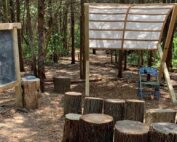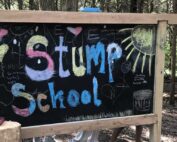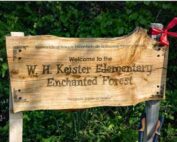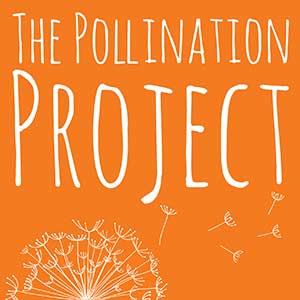Worm Workers
Rebecca Bland
Washington County Public Schools, Maryland
The hum of busy fifth graders at work is obvious to any visitor that stops by their classroom at Salem Avenue Elementary School in Hagerstown, Maryland. What is not so obvious is the silent work of thousands of red wigglers – a type of composting earthworm – living in a vermiculture tub in the back of the room. These small earthworms are turning apple cores and banana peels students have buried in the worms’ peat moss bedding into “vermicastings” – a kind of natural fertilizer.
The year-long vermiculture (“worm culture”) project, supported by the science department at WCPS, enriches the fifth-grade educational experience in a number of ways. First of all, it spotlights the importance of decomposers in the study of food chains and webs. The up close and personal nature of vermicomposting motivates students to consider the busy world that lies beneath their feet when they are outside – a world upon which their lives depend.
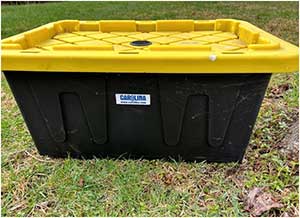 The students, growing ever more curious about the worms they feed, are full of questions. “How do the worms find the food we bury?” they ask. “Can they see? Can they smell? Which end is their head?” What educator doesn’t long for students to ask those authentic questions that lead to exciting research? The students find answers to their questions in various books and articles, including the well-known Worms Eat My Garbage by Mary Appelhof.
The students, growing ever more curious about the worms they feed, are full of questions. “How do the worms find the food we bury?” they ask. “Can they see? Can they smell? Which end is their head?” What educator doesn’t long for students to ask those authentic questions that lead to exciting research? The students find answers to their questions in various books and articles, including the well-known Worms Eat My Garbage by Mary Appelhof.
At first, the research is their own, but it soon extends beyond the classroom. “We should show the worms to our Pre-K buddies!” one student exclaims. Without hesitation, the students take on the role of teachers. As the fifth graders consider their audience, they learn that the process of organizing and presenting information in its simplest form ensures that they, themselves fully understand it.
The science department is happy to provide a second worm bin for the fifth graders to present to their Pre-K buddies. As the students educate the youngest members of their school in vermiculture, they find themselves advocating for the recycling of organic waste, a concept foreign to many students in an urban setting.
Later on, in the spring, the fifth graders proudly show their Pre-K buddies the lettuce garden they have cultivated in a corner of the playground, enriching the soil with “compost tea” they have made from worm castings mixed with water.
By now the fifth graders have increased their store of knowledge through interdisciplinary work in social studies. In the book Farmer George Plants a Nation by Peggy Thomas, they read how George Washington experimented with different kinds of manure for organic composting, and how he shared the results of his experiments with other farmers. They are fascinated by the fact that the man whose face appears on the U. S. dollar bill was not only a president but also a scientist who dug in the dirt and planted seeds.
One day during the last week of school, the students harvest the lettuce from their garden and set up a salad bar to accompany their cafeteria lunch. As they laugh and talk together over plates piled high with lettuce, cucumbers, and celery, the worm workers eat quietly away at organic leftovers in their bin – unaware of the insights they have helped fifth graders obtain – insights into the importance of their own role in safeguarding and enriching the natural environment outside their door.
Share
LATEST RESOURCES
Building an Outdoor Classroom Amphitheater
Building an Outdoor Classroom Amphitheater
Dan Balkan
James Madison University
Designing Outdoor Classrooms: Transforming Learning Spaces for Nature Connection
Designing Outdoor Classrooms: Transforming Learning Spaces for Nature Connection
Lily […]
Keister Elementary’s Enchanted Forest
Keister Elementary’s Enchanted Forest
Brooke Imber
Harrisonburg City Public Schools, Virginia […]


